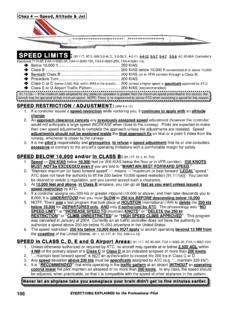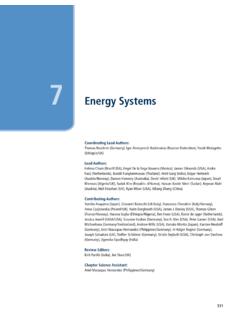Transcription of Chap 7 — Commercial Operations Part 91 vs Parts …
1 EVERYTHING EXPLAINED for the Professional Pilot 239 part 91 vs Parts 121/135 ( ) part 91 Parts 121/135 1. A Commercial pilot may fly as a part 91 Corporate pilot flying a company airplane carrying company property and passengers. 2. May provide part 91 pilot service whereas a Commercial pilot is paid by an airplane owner to fly the airplane for the owner and his guests. 3. May provide private carriage for hire for one customer or a few select customers. 4. May also perform the services listed in that are not covered under part 135 regulations ( , student instruction, nonstop sightseeing flights within 25 NM, ferry flights, crop dusting, banner towing, pipeline patrol, etc.). 1. Requires an Air Taxi/ Commercial Operator Certificate . 2. Can hold out to the public and offer common carriage to anyone who is willing to pay.
2 3. Can advertise and offer carriage in air commerce of persons or property for compensation or hire. No minimum flight experience required. A part 135 PIC must have at least 500 hours total time (..etc.) for VFR Operations and at least 1200 hours total time (..etc.) for IFR Operations . For part 135 PIC an ATP is required for turbojets, or airplanes with 10 or more passenger seats, or multiengine commuter Operations . ( ) A part 121 PIC must have an ATP. [ (a)] A Second In Command is not required for instrument flight in aircraft that are normally flown single pilot. A Second In Command is required when carrying passengers under IFR unless the operation (and the pilot) is approved for use of an autopilot in lieu of a Second In Command. ( , ) No training program required. An FAA approved training program is required for all 135 Operations except simple single pilot operators.
3 No drug and alcohol program required for most Operations [except drug testing is required for nonstop sightseeing flights see (a)(5)]. Must have a drug and alcohol random testing program for all employees in safety sensitive positions. This would include anyone the operator contracts with, such as when maintenance is performed by another facility away from home base. ( thru & 121 appendix I & J) Background checks NOT required. FIVE YEAR background checks are required due to the Pilot Records Improvement Act of 1996 (PRIA): 1. A check of all previous employers for training or checkride problems and drug testing history. 2. An FAA records check of the pilot s certificate and medical including any accidents or incidents. 3. A check of the pilot s driving record for any drug or alcohol related motor vehicle actions.
4 No flight time limits, duty time limits or rest requirements. thru ( thru ) regulates crew flight time, duty time and rest requirements. Any airport may be used IFR or VFR as long as it is adequate for the aircraft and is in compliance with the limitations of the Aircraft Flight Manual. The airport must have WEATHER REPORTING and be of adequate length to meet required accelerate stop/accelerate go distance (for most aircraft) and meet the 60%/70% (destination/alternate) landing limitation rules. ( thru ; thru ) An instrument approach may be initiated regardless of the weather. A pilot may not begin an instrument approach unless the latest weather reports at least minimums for the approach. [ , (b)] Chap 7 Commercial Operations EVERYTHING EXPLAINED for the Professional Pilot 240 Pilot In Command QUALIFICATIONS: ( , , , , thru , , thru ) 1.
5 part 135 VFR: a. Commercial / Instrument / Multi-Engine ratings (for multi-engine Operations ), and 2nd Class Medical. b. Must be instrument current, also company trained and line checked ( , ) in the aircraft within the last 12 months. c. TOTAL PILOT TIME .. 500 hours d. Total cross country .. 100 hours e. Night cross country .. 25 hours 2. part 135 IFR: a. Commercial / Instrument / Multi-Engine ratings (for multi-engine Operations ), and 2nd Class Medical. b. Must be company trained and line checked ( , ) in the aircraft within the last 12 months and instrument checked ( ) within the last 6 months. c. TOTAL PILOT TIME .. 1,200 hours. d. Total cross country .. 500 hours. e. Total night .. 100 hours. f. Night cross country .. 25 hours. g. 75 hours of actual or simulated instrument time at least 50 hours of which were in actual flight.
6 3. For PASSENGER-carrying Operations only No person may serve as PIC of a turbojet, or an airplane having 10 or more passenger seats, OR a multiengine airplane in a commuter operation unless he holds an Airline Transport Pilot certificate and a current 1st Class Medical ( ). 4. For COMMUTER Operations , the PIC must also have the Initial Operating Experience (IOE) outlined in (or )( , 20 hours in a multiengine turbine or 25 hours in a turbojet with a qualified check pilot that can be acquired during revenue flights. The hours can be reduced by 50% by the substitution of one additional takeoff and landing for each hour of flight. See Initial Operating Experience in Chapter 8 of this book for specific details). 5. part 121 No pilot may act as Pilot In Command of an aircraft (or as Second In Command of an aircraft in a flag or supplemental operation that requires three or more pilots) unless he holds an Airline Transport Pilot certificate and an appropriate type rating for that aircraft.
7 [ (a)] RECENT PILOT EXPERIENCE for Pilot In Command: ( , , , , ) 1. To carry PASSENGERS the PIC must have 3 takeoffs and landings in an aircraft of the same category and class in the past 90 days these landings must be made to a full stop if in a tailwheel aircraft or at night and if a type rating is required must be in the same type of aircraft. ( , ) For part 121 Operations the three takeoffs and landings are required for ANY flight crewmember regardless of if passengers are carried or not. ( ) 2. For Operations at NIGHT (between 1 hour after sunset and 1 hour before sunrise), the same as #1 above during this same 90 day period of time. 3. If the PIC has not flown over a route and into an airport within the preceding 90 days the pilot must become familiar with all available information required for the safe operation of the flight [ (c), ].
8 Hi, my name is Captain Dudley. If it s got wings, I can fly it. TOP SECRET CAPTAIN STUFF #1. Point the airplane where you want to go, if it doesn t go that way POINT HARDER. #2. If you don t want the airplane to go over there DON T LET IT GO OVER THERE. Chap 7 Commercial Operations EVERYTHING EXPLAINED for the Professional Pilot 259 IFR TAKEOFF Minimums Continued: [ (f), , , , , , , , , , OpSpec C057 & C079] A. TWO PILOTS Flightcrew of two required pilots (required by the regulations or the type certification of the aircraft) Check non-standard. 1. Mile or RVR 1600 AT LEAST ONE of the following: a. High Intensity Runway Lights (HIRL). b. Centerline Lights (CL). c. Centerline Marking (RCLM). d. Adequate visual reference to continuously identify the takeoff surface.
9 2. TDZ RVR 1200 and Rollout RVR 1000 and must have BOTH of the following: a. Centerline Lights (CL). b. Two RVR reporting systems. 3. TDZ RVR 600, Mid RVR 600, and Rollout RVR 600, provided ALL of the following visual aids and RVR equipment are available: a. Centerline Lights (CL). b. Centerline Markings (RCLM). c. At least two of the three RVR reporting systems must be working. NOTES: 1. Mid RVR may be substituted for either TDZ RVR or Rollout RVR if TDZ RVR or Rollout RVR is not available. 2. Use of autopilot in lieu of a required 2nd-in-command IS NOT authorized. 3. Each pilot station must have: a. An Attitude Indicator, DG, VSI, Airspeed and Altimeter. b. An independent source of power for Attitude and DG. 4. Each PIC and SIC must have at least 100 hours PIC (or SIC) in specific make & model and have completed company training program for the minimums authorized.
10 5. For takeoffs when TDZ and rollout RVR is less than RVR 1000, the aircraft must be able to achieve performance specified in FAR , , or as appropriate (Must have ACCELERATE-STOP DISTANCE the distance required to accelerate to liftoff speed and, assuming failure of an engine at the instant that liftoff speed is attained, to bring the airplane to a full stop and/or be able to climb to 35 ft before the end of the runway on one engine if it fails at V1 aka ACCELERATE-GO DISTANCE ). [C079d.(6)] 6. If you TAKEOFF with weather BELOW landing minimums for all practical purposes you cannot return to land if you lose an engine after takeoff. Therefore, you must FILE (or list in the dispatch or flight release) a TAKEOFF ALTERNATE (aka DEPARTURE ALTERNATE ) that is within ONE hour s flying time at normal cruise speed, in still air ; at normal cruise speed in still air with one engine inoperative ) TWO hour s flying time for an aircraft with 3 or more engines.









